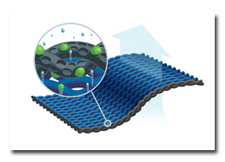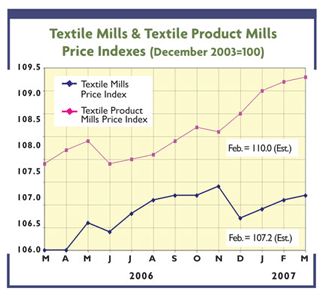Cocona™, TrapTek LLC’s patented innovative technology that incorporates activated carbon derived from recycled coconut shells into fibers and yarns, has received accolades as a natural, sustainable technology that provides evaporative cooling and moisture management, and traps odors and ultraviolet (UV) rays within the activated carbon’s pore structure. The technology was developed in 2002 by Gregory W. Haggquist, Ph.D. — the Longmont, Colo.-based company’s founder — and made its consumer market debut in 2006 in knitted cycling apparel developed by United Knitting, Cleveland, Tenn., and Bethel, Conn.-based Cannondale Bicycle Corp.
Last year, Burlington WorldWide (BWW), a business unit of Greensboro, N.C.-based International Textile Group Inc., received exclusive rights to develop, license and market woven fabrics using Cocona technology, first offering a line of man-made fiber fabrics primarily for activewear, and then adding cotton blends and entering more mainstream markets. Just recently, it added a collection of wool-blend fabrics to its Cocona line, which now includes about 20 man-made, 15 cotton and six to 10 wool styles.
According to Nelson Bebo, vice president of Burlington Labs, BWW’s research and development division, BWW, with its global reach, has been working with TrapTek for 18 months to two years, and Burlington Labs was instrumental in bringing the Cocona technology into commercial yarn and fabric markets.
“TrapTek came up with some pretty interesting intellectual property (IP), but it was just a small IP company and needed help in commercializing the technology,” Bebo said.

The nanoscale pore structure of activated coconut carbon used in Cocona adsorbs moisture, odors
and UV rays, which are then released during laundering using a scent-free detergent and dyeing
using a heat source.
The Cocona Story
The Cocona technology imbedsactivated carbon from coconut shells into polyester or nylon polymers. The coconut shells, recycled waste from the food industry, are burned at 300°C followed by a 1,000°C steam-activation process. The activated carbon thus produced is imported by suppliers to water and air filtration, wastewater treatment, and other such industries. The microscopic, ultrafine particles that are too small for those applications are just what TrapTek needs to incorporate into its fiber and yarn.
“Not only are we using a green material, but we’re recycling what would have been thrown into landfills,” said Jonathan Erb, a principal at TrapTek. “This is encapsulated to provide a durable surface that allows the activated carbon to go through the very rigorous processing of polyester or nylon fibers and survive that process. The protective coating actually comes off during the course of fiber extrusion, and that releases activated carbon to be very much a part of that fiber.”
According to Erb, the coconut shell’s hardness, created by the nanometer-scale pore structure, gives it an advantage over softer activated carbon materials, which have fewer and bigger pores. The coconut pore structure is very complex, and the size of the pores is very even, he said. These pores adsorb moisture, odors and UV rays and through the exothermic adsorption process cause moisture to evaporate quickly. TrapTek says activated carbon from coconut shells
exhibits a greater exothermic reaction than any other known substance, and garments containing Cocona activated carbon show 45-percent greater wickability and significantly higher drying rates than garments offering conventional moisture-management technologies.
Cocona fabrics and garments are rejuvenated and trapped odors removed by laundering using scent-free detergents and drying using a heat source and no dryer sheets. Bebo said 60 to 70 percent of odors are removed during washing, and the heated drying causes the remaining odors to vibrate and move out of the pores.
Erb said most alternative moisture management fabric treatments are topical chemical applications, “whereas ours is integral to the fiber, which can be combined very nicely with other fibers such as man-made, wool or cotton to give new attributes to those fabrics.”
In blends, the ratio of Cocona to other fibers is based increasingly on end-use profiles, Bebo said. “For knit socks, you might want more Cocona than for everyday apparel to get the full benefits of the technology as it relates to odor control. In most applications, the percentage of Cocona is based on fabric weight, and 40 percent tends to be ideal for the types and weights of fabrics BWW does. As a fabric goes up in weight, the percentage could go down so the weight stays
the same,” he explained.
 Burlington WorldWide’s Cocona Wool fabrics are offered in a range of weights and constructions
Burlington WorldWide’s Cocona Wool fabrics are offered in a range of weights and constructions
suitable for military and service uniforms, business suits, dress apparel and everyday wear.
BWW’s Cocona Wool
Bebo noted the Cocona technology, combined with the sustainability movement, makes it a natural especially for better brands participating in the activewear market, but it also has moved into mainstream, everyday apparel. He said BWW offers its man-made and cotton-blend Cocona fabrics in both of those markets.
The new wool fabrics, offered in a range of weights and constructions, are targeted to military and service uniform sectors, as well as for business suits, other dress apparel and everyday wear — and even possibly “as an item in a golf collection,” Bebo suggested. Some also offer a bit of stretch.
“There’s been lot of innovation lately in wool, whether it be wrinkle-free, washable,
stain-repellent — as with BWW’s new Invisible Barrier™ technology — or whatever,” Bebo said. “ Everything is focusing on the technology to drive easier care, better performance. With wool, for example, take the cool suit: How do you make a wool suit more comfortable? You can take Cocona yarn, blend it with wool, and get performance benefits including exceptional moisture wicking and evaporation to add comfort — plus you have the sustainability story.”
For more information about Cocona, contact Jonathan Erb (720) 652-9726, Ext. 105, jon@traptek.com. For more information about BWW’s Cocona fabrics, contact Nelson Bebo (212) 621-4046, nelson.bebo@burlington.com.
April 10, 2007







